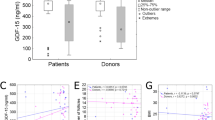Objective
Relationships between immune and endocrine systems seem to occur in ovarian follicular fluids (FF). Lymphomonocytes have been found in preovulatory follicles and their specific products, cytokines [interleukin-1 (IL1), IL2], were demonstrated to inhibit steroidogenesis. Ovarian steroids, in turn, reduce the cytokine production from immune-competent cells. In the present study we evaluated whether lymphomonocytes are present in FF, and if both their subset distribution and their IL1α and IL2 secretions, after activation with phytohemagglutinin (PHA), are similar to those of peripheral blood. Interferences of IL1α and IL2 production by FF lymphomonocytes caused by isolated granulosa cells were also evaluated.
Participants
The study was performed on 86 FFs obtained from follicles containing mature oocytes that were aspirated at the time of ovum pickup from 27 women undergoing controlled ovarian hyperstimulation with exogenous gonadotropins for an in vitro fertilization (IVF) program [IVF—embryo transfer (IVF-ET) or gamete intrafallopian transfer (GIFT)].
Results
Lymphocytes were found in FF. The distribution of CD8+ and CD3+ lymphocyte subsets is equal to that in peripheral blood, but the percentage of CD11b+, CD16+, and CD4+ cells (its trend) is higher in FF than in peripheral blood. The amount of IL2 and IL1α deriving from PHA-activated FF lymphomonocytes is similar to that of peripheral blood PHA-activated lymphomonocytes. Granulosa cells significantly blunt IL2 and IL1α production by FF lymphomonocytes.
Conclusions
These results suggest that preovulation, a migration of lymphomonocytes from the peripheral compartment to the follicle occurs. However, unfavorable effects of IL2 and IL1α, cytotoxic and antisteroidogenetic activities, are counteracted by the products of granulosa cells. The higher amounts of CD11b+, CD16+, and CD4+ in FF suggest that they could be involved in other immune processes.
Similar content being viewed by others
References
Weakly BS: Electron microscopy of the oocyte and granulosa cells in the developing ovarian follicle of the golden. J Anat 1966;100:503–507
Khan SA, Schmidt K, Hallin P, Di Pauli R, De Geyter Ch, Nieschlag E: Human testis cytosol and ovarian follicular fluid contain high amounts of interleukin-1 like factor(s). Mol Cell Endocrinol 1988;58:221–230
Grossman CJ: Interactions between the gonadal steroids and the immune system. Science 1985;227:257–261
Gottschall PE, Katsuura G, Hoffman Si, Arimura A: Interleukin 1: An inhibitor of luteinizing hormone receptor formation in cultured rat granulosa cells. FASEB J 1988;2:2492–2496
Gottschall PE, Katsuura G, Arimura A: IL-1 suppresses follicle stimulating hormone induced estradiol secretion from cultures ovarian granulosa cells. J Reprod Immunol 1989;15:281–290
Fukuoka H, Taii S, Yasuda K, Takakura K, Mori T: Interleukin 1 stimulates growth and inhibits progesterone secretion in the cultures of porcine granulosa cells. Endocrinology 1989, 124:884–890
Yasuda K, Fukuoka H, Taii S, Takakura K, Mori T: Inhibitory effects of interleukin-1 on follicle stimulating hormone induction of aromatase activity, progesterone secretion, and functional luteinizing hormone receptors in cultures of porcine granulosa cells. Biol Reprod 1990;43:90–96
Barak V, Yanai P, Treves AJ, Roisman I, Simon A, Laufer N: Interleukin-1: Local production and modulation of human granulosa luteal cells steroidogenesis. Fertil Steril 1992;58:719–725
Kasson B, Gorospe W: Effect of interleukins 1, 2 and 3 on follicle-stimulating hormone-induced differentiation of rat granulosa cells. Mol Cell Endocrinol 1989;62:103–111
Wang L, Robertson S, Seamark RF, Norman RJ: Lymphokines, including interleukin-2 alter gonadotropin-stimulated progesterone production and proliferation of human granulosa-lutein cellsin vitro. J Clin Endocrinol Metab 1991;72:824–831
Castilla JA, Sampalo A, Molina R, Samaniego F, Mozas J, Vergara F, Garrido F, Herruzzo AJ: Mononuclear cells subpopulations in human follicular fluid from stimulated cycles. Am J Reprod Immunol 1990;22:127–129
Hume DA, Halpin D, Charlton H, Gordon S: The mononuclear phagocyte system of the mouse defined by immunohistochemical localization of antigen F4/80: macrophages of endocrine organs. Proc Natl Acad Sci USA 1984;81:4174–4180
Loukides JA, Loy AR, Edwards R, Honig J, Visentin I, Polan ML: Human Follicular Fluids contain tissue macrophages. J Clin Endocrinol Metab 1990;71:1363–1367
Hurwitz A, Loukides J, Ricciarelli E, Botero L, Katz E, McAllister JM, Garcia JE, Rohan R, Adashi EY, Hernandez ER: Human intraovarian interleukin-1 (IL-1) system: Highly compartmentalized and hormonally dependent regulation of the genes encoding IL-1, its receptor, and its receptor antagonist. J Clin Invest 1992;89:1746–1754
Smith KA: Interleukin-2: Inception, impact and implications. Science 1988;240:1169–1174
Droesch K, Fulgham DL, Liu HC, Rosenwaks Z, Alexander NJ: Distribution of T cell subsets in follicular fluid. Fertil Steril 1988;50:618–621
Hill JA, Barbieri RL, Anderson DJ: Detection of T8 (suppressor/cytotoxic) lymphocytes in human ovarian follicular fluid. Fertil Steril 1987;47:114–117
Castilla JA, Sampalo A, Gil T, Vergara F, Molina R, Herruzzo AJ: CD8+ lymphocyte subsets in human follicula fluid. Fertil Steril 1992;57:1124–1125
Weusten JJAM, Blankenstein MA, Gmelig-Meylig FHT, Schuurman HJ, Kater J, Thijssen JH: Presence of oestrogen receptors in human mononuclear cells and thymocytes. Acta Endocrinol (Copenh) 1986;112:409–413
Pfeifer RW, Patterson RM: Modulation of lymphokineinduced macrophage activation by estrogen metabolites. J Immunopharmacol 1985;7:247–263
Polan ML, Daniele A, Kuo A: Gonadal steroids modulate human monocyte interleukin-1 (IL-1) activity. Fertil Steril 1988;49:964–968
Mantovani G, Macciò A, Zucca MV, Serra MC, Proto E, Locci F, Arangino V, Manduco D, Sulis G, Puxeddu P, Del Giacco GS: Immunologic assessment determined by response to IL-2 and immunophenotyping of tumor-infiltrating lymphocytes, of invaded and non-invaded lymph nodes and of peripheral blood lymphocytes from twenty-one patients with primary laryngeal cancer. J Biol Regul Homeost Agents 1989;3:25–34
Hurwitz A, Hernandez ER, Payne DW, Dharmarajan AM, Adshi EY: Interleukin-1 is both morphogenic and cytotoxic to cultured rat ovarian cells: Obligatory role for heterologous, contact-independent cell-cell interaction. Endocrinology 1992;131:1643–1649
Halme J, Hammond MG, Syrop CH, Talbert LM: Peritoneal macrophages modulate granulosa cell progesterone production. J Clin Endocrinol Metab 1985;61:912–916
Wang LJ, Normal RJ: Concentrations of immunoreactive interleukin-1 and interleukin-2 in human preovulatory follicular fluid. Hum Reprod 1992;7:147–150
Takakura K, Tai S, Fukuoka M, Yasuda K, Tagaya Y, Yodoi J, Mori T: Interleukin-2 receptor/p55 (Tac)-inducing activity in porcine follicular fluids. Endocrinology 1989;125:618–622
Author information
Authors and Affiliations
Rights and permissions
About this article
Cite this article
Macciò, A., Mantovani, G., Turnu, E. et al. Evidence that granulosa cells inhibit interleukin-1α and interleukin-2 production from follicular lymphomonocytes. J Assist Reprod Genet 10, 517–522 (1993). https://doi.org/10.1007/BF01204362
Received:
Accepted:
Issue Date:
DOI: https://doi.org/10.1007/BF01204362




